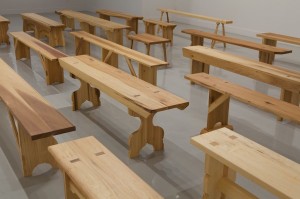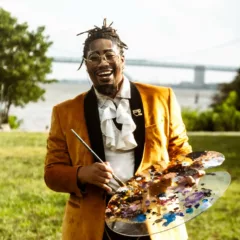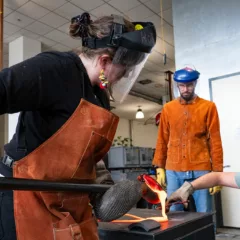Francis Cape‘s 20 spare poplar benches at Arcadia University Art Gallery imply people sitting together purposely (if not comfortably) maybe in church or while eating a meal in a dining hall. Cape’s benches, all hand-made by the artist in the last two years, are replicas of seating used by the Shakers, Hutterites and 14 other utopian communities. They are functional furniture, but more than that, they are a conceptual art project. Lined up in rows, each bench facing the center of the room, Cape’s benches represent the idea that sitting on the same bench is about something more than just sitting. The piece is about communalism — people coming together with common purpose to share hopes and ideals and live meaningful, harmonious lives. At a time when the Occupy movement is launching its own utopian community, Cape’s benches are perfect.

“The benches invoke the tradition of free speech and communal discourse,” said Arcadia’s Gallery Director Richard Torchia. “The effect of the benches on the room is to create a secular sacred space…full of the possibility for speech and for listening to speeches.”
At the lecture before the show’s opening Nov. 15, Cape began with a reference to the Occupy movement and went on to talk about his benches. “The benches are about the way we live,” he said. Referring to Bill Brown’s thing theory, Cape explained that benches are things and not objects. “A thing has been around a long time. Things are part of the fabric of society. They have a social factor.” Objects, according to this theory, are what gets mass-produced and ultimately thrown away.

Cape’s benches were made before the Occupiers got started. The portable benches also are a new way of working for the artist. Before this, Cape made works that were architectural, often built right into the walls of a gallery. He’s never had works capable of traveling like these benches, which will be shown in Maine and Santa Fe and perhaps elsewhere.
But the socially-aware artist, who put a 1972 trailer home under the Highline in Manhattan in 2010 to make a point about trailer parks not being parks and trailers not being homes, is very much about ideas of social justice, income inequality, and communalism. “We should return to utopian times,” he said. “Capitalism is about rugged individualism; in communalism, we’re all in it together. Well, I’m an old hippie,” he chirped, as if that explained.
“For Francis, the idea of shared property galvanized him,” said Torchia. That, and the idea that what weakened the communes is the American concept of property ownership, according to Torchia.
In the small takeaway book Cape researched for the show, he wrote, “Perhaps current disgust with money and politics will lead a new secular communal movement.” The book describes the histories of ten historical utopian communities and 15 local communities, some of them, like Father Divine’s Peace Ministry, still in operation. “The most salient paragraphs [that explain Cape’s thinking about the project] are in the front of the book…The fact that [in the communes] labor was not considered drudgery…Working was a blessing. They made things to last,” said Torchia.
The benches are intended to be used. Arcadia has reached out to their faculty, who have used the benches for classes. They have reached out to Abington Friends Meeting and to Haverford College (both Quaker institutions) and will reach out to Father Divine’s Peace Institute. On Dec. 13, there will be a discussion of utopias, open to the public. If you have an idea for a public meeting on the benches, you are welcome to email the gallery. gallery@arcadia.edu
Cape, a British-born artist now an American citizen, lives in Narrowsburg, a small town in rural upstate New York. He is a dedicated wood worker who apprenticed with a wood carver before he got a degree in art (Goldsmiths, London, 1991). Under that apprenticeship, he worked in restoration — restoring very old things, he said. In this exhibit he is restoring the idea of communalism, returning it to a place at the table or on the bench.

Not all artist-made furniture is conceptual but all of it is utopian – full of heart and craftsmanship and an appreciation for the value of work. Bristol artist Kevin Strickland‘s furniture at Works on Paper Gallery embodies ideas these ideas. Strickland’s furniture, with exquisite mortise and tenon joints and no metal fasteners, is exquisite. The dining chairs, which have leather seats, are very comfortable for a lengthy discussion over dinner. Strickland, who graduated from Pennsylvania Academy (MFA 1996), designs his own furniture and his philosophy weaves together “clarity and complexity…an economy of means, …nuance, and sublety.” You will not find that philosophy in mass-produced objects.
From the Center for Art in Wood and the Clay Studio, to the Fiber Art International, the annual Craft Show, the annual furniture show and the Philadelphia Art Alliance’s new focus on craft and design, there is a tradition of making and of supporting finely crafted works in Philadelphia. While not directly related to the area’s history of communal societies, this embrace of the crafted is in its own way an embrace of a utopian ideal of beauty in the dignified labor of the craftsperson.
Francis Cape: Utopian Benches, to Dec. 18. Crafting Ideal America: Material Culture and American Utopianism. Public discussion led by Lynsey Graeff, Honors Student and Graduating Senior, Temple University. Wednesday, December 14, 4:30 – 5:30 PM. Reception following. Arcadia University Art Gallery, Glenside. www.arcadia.edu/gallery 215 572 2131
Kevin Strickland: Furniture vs Art, to Jan. 21. Works on Paper Gallery, 1611 Walnut St. www.worksonpaper.biz 215 988 9999
This article ran in the Daily News Dec. 2, 2011, part of Art Attack, a partnership with Drexel University supported by a grant from the Knight/NEA Community Arts Journalism Challenge, administered by the Greater Philadelphia Cultural Alliance.










